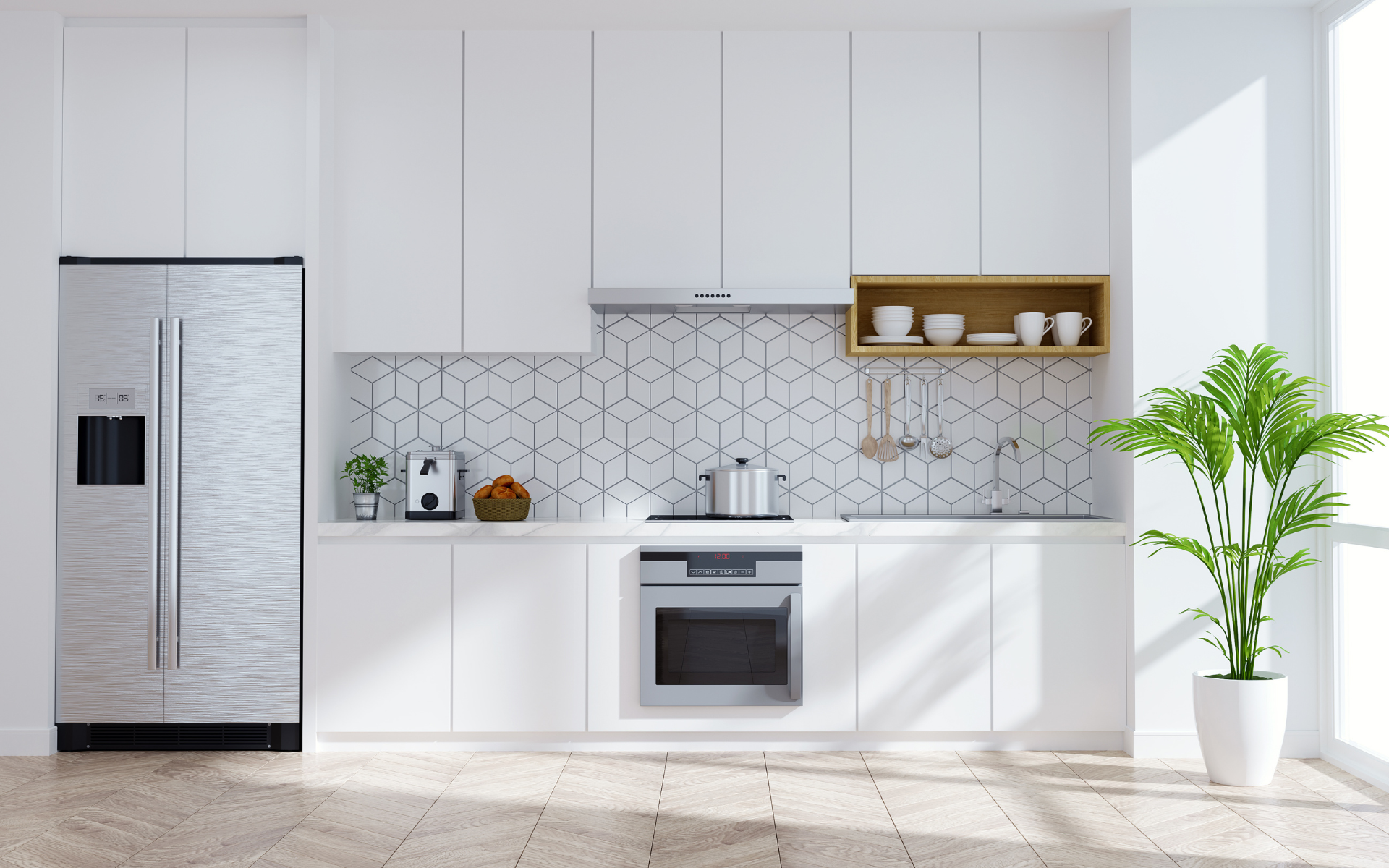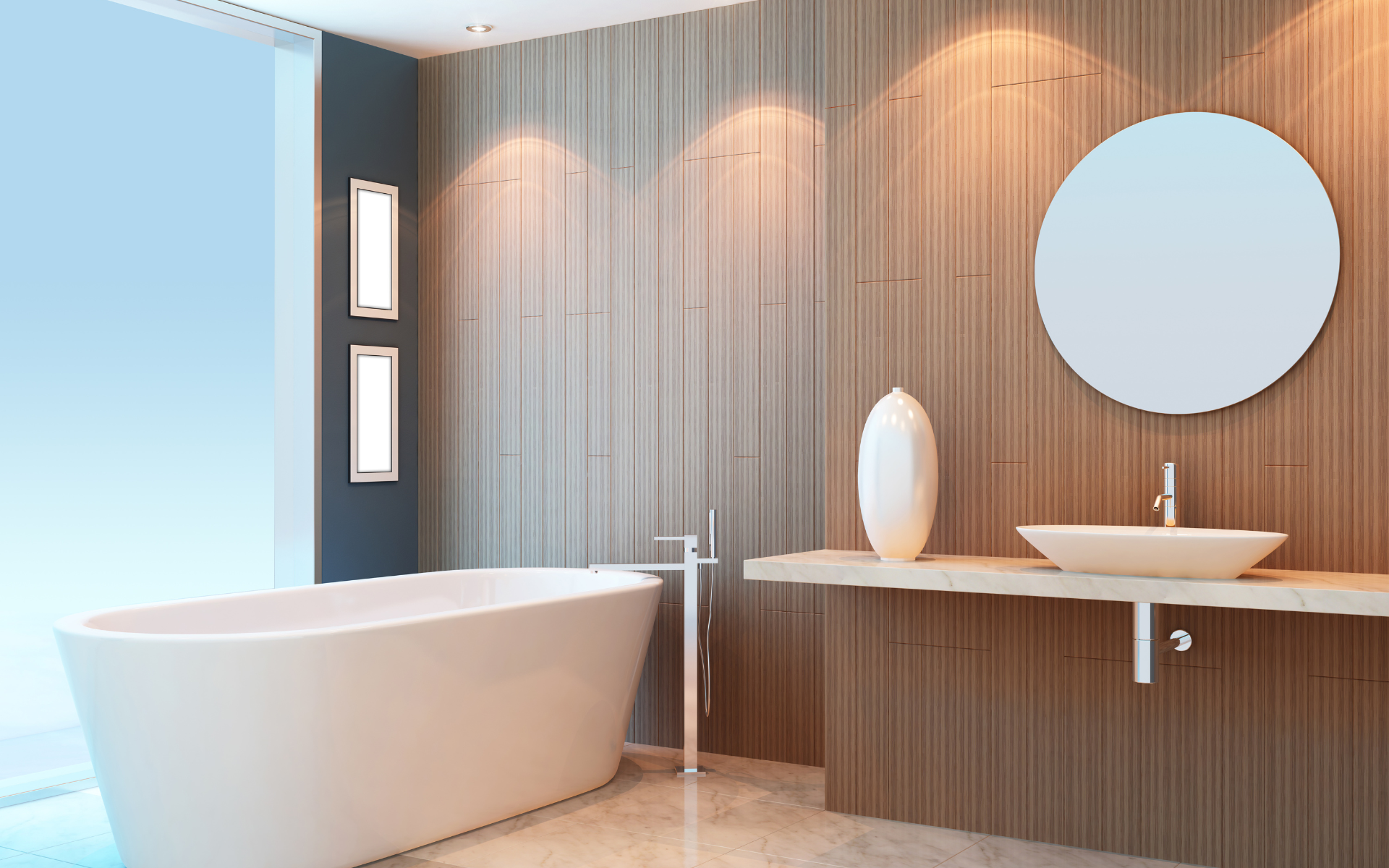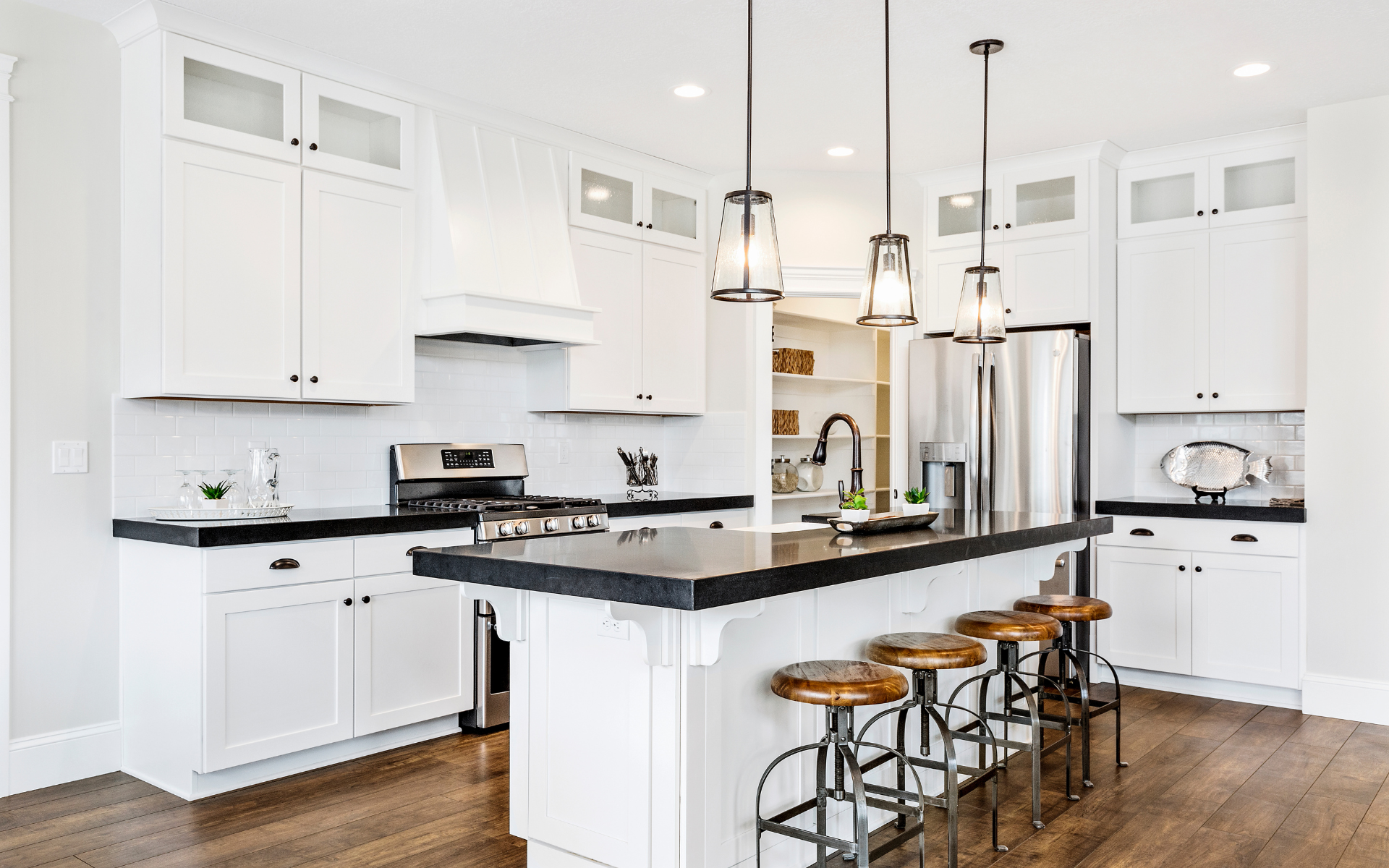The kitchen remains the heart of every home. Creating a functional and convenient space for everyone requires thoughtful planning. When this vital area needs a kitchen remodel, establishing a proper kitchen remodeling budget prevents you from breaking the bank while achieving outstanding results.
Setting a realistic budget prevents overspending and helps achieve your dream kitchen within your means. As a trusted kitchen and bath remodeling company, we recommend smart strategies to maximize your investment. A kitchen remodel costs around $10,000 for a minor remodel to over $65,000 for a major, upscale one, according to Angi’s 2025 data. However, you can achieve exceptional results with careful planning and strategic choices.
Table of Contents
Current Kitchen Renovation Cost Trends in 2025
The average total cost of a renovation in 2025 is $71,159 for a medium-sized kitchen and $137,228 for a large one. This represents a significant investment, making it essential to establish a proper kitchen remodeling budget before starting your project.
According to the U.S. Houzz Kitchen Trends Study, the median cost for a minor kitchen remodel is $18,000. The median cost for a major remodel, when at least all the cabinets and appliances are replaced, is $55,000. These figures show a 19% to 22% increase since 2022, highlighting the importance of thorough budget planning.
The cost breakdown for kitchen renovation typically follows this pattern:
Cabinets: 29% of total budget
Labor: 17% of total budget
Appliances: 14% of total budget
Countertops: 10% of total budget
Flooring: 7% of total budget
Lighting: 5% of total budget
7 Practical Tips for an Affordable Kitchen Renovation

1. Keep the Existing Layout
Maintaining your current floor plan delivers the most significant cost savings for your kitchen project. Changing the layout adds substantial expense to your kitchen renovation cost. Moving plumbing fixtures like the sink or relocating electrical components requires professional installation, increasing both material costs and labor expenses.
Dramatically changing the layout can quickly drive up your kitchen remodel budget. For instance, moving the plumbing for your sink, dishwasher or refrigerator requires extensive work from licensed professionals.
If your average kitchen remodel costs $36,500, layout changes add $2,000 to $5,000 in additional expenses. Keep appliances and plumbing in their current locations to maintain a realistic budget for your minor remodel.
2. Transform Existing Cabinets Instead of Replacing
Cabinet hardware and cabinet updates offer tremendous value without the expense of new cabinets. Cabinets represent almost 30% of kitchen renovation costs, making this area crucial for cost management.
Paint your existing cabinets with high-quality materials for a fresh appearance. Choose colors that complement your house and create a cohesive design. Professional cabinet painting costs significantly less than custom cabinet installation.
Replace cabinet hardware with modern handles and hinges. Bronze, copper, or satin finishes provide a contemporary look that transforms outdated cabinetry. Take existing hardware to your local store to ensure proper sizing for the new installation.
For cabinets beyond repair, consider stock or prefab options. These provide quality construction at lower material costs compared to custom cabinetry.
3. Upgrade Lighting for Safety and Style
Proper lighting addresses both safety and aesthetic concerns in your kitchen space. Poor lighting creates dangerous conditions when using knives or cooking equipment.
Install ambient lighting like recessed fixtures throughout the kitchen. LED options reduce long-term electrical costs while providing excellent illumination. Add task lighting above work areas and under cabinets for detailed food preparation.
Accent lighting creates visual interest through pendant fixtures over islands or dining areas. It costs an average of $260 to install a new faucet and $420 to install a new sink, but lighting upgrades often provide better value for your investment.
Natural light from windows reduces utility expenses and creates an inviting atmosphere. Consider window placement during your planning phase.
4. Refinish Flooring Rather Than Replace
Flooring updates consume a significant portion of your kitchen remodeling budget. Professional hardwood refinishing costs $3 to $5 per square foot, making it much more affordable than complete replacement.
For a 500 square foot kitchen, refinishing costs $1,500 to $2,500 compared to $4,000 or more for new installation. The process involves cleaning, repairing damage, sanding, buffing, applying stain or sealant, and final buffing.
Tile upgrades benefit from creative approaches like stenciling to create new patterns without replacement costs. This technique provides dramatic visual impact while keeping expenses within your budget range.
5. Strategic Appliance Selection
54% of homeowners choose to replace all their appliances during a renovation, and nearly half of them are opting for high-tech units with features like Wi-Fi connectivity and touch-screen displays.
Focus on energy-efficient appliances that reduce monthly payment obligations through lower utility bills. Mass-market products often provide excellent performance without the premium price of professional-grade equipment.
Buy appliances during sales events to reduce costs. Research warranty coverage and energy ratings to ensure long-term value. A quality refrigerator, range, and dishwasher form the foundation of a functional kitchen.
6. Choose Quality Materials
Choose materials that balance style and cost. Laminate and ceramic are the most budget-friendly, while marble is the most costly for countertops.
Stone remnants provide the beauty of natural materials at reduced prices. These pieces work well for smaller kitchens or specific areas like islands. Quartz and granite offer durability and visual appeal when purchased strategically.
For backsplash installation, subway tile and ceramic options deliver classic style without premium pricing. Consider DIY installation for simple patterns to cut costs further.

7. Maximize Storage Through Smart Design
Proper furniture arrangement improves traffic flow without increasing space requirements. The work triangle connecting your sink, refrigerator, and cooking area should remain efficient for optimal function.
Choose multifunctional furniture like movable islands or tables with storage. These pieces adapt to different needs while providing extra counter space for food preparation.
Built-in organizers, pull-out shelves, and drawer dividers maximize existing cabinet space. These accessories cost less than additional cabinetry while improving functionality.
Additional Kitchen Remodeling Budget Strategies
Best DIY Projects to Cut Costs
Handle appropriate tasks yourself to reduce labor costs. Painting, demolition, and material pickup eliminate contractor charges. Remove old cabinets, countertops, or appliances before professionals arrive to reduce disposal fees.
If you have the time, tools, and know-how, doing parts of your kitchen remodel yourself can trim the cost. However, leave plumbing, electrical, and gas line work to licensed professionals for safety and code compliance.
Tips to Source Kitchen Materials
Pick up supplies yourself instead of paying delivery charges. Compare prices from multiple suppliers to find the best deals. Consider purchasing floor models or overstock items for significant savings.
Shop end-of-season sales for appliances and fixtures. Many retailers offer substantial discounts during slow periods.

Financing Your Kitchen Project
A realistic budget for a kitchen remodel can range anywhere from $15,000 to $50,000, depending on the size of the kitchen and the finishes you choose. Several financing options help manage cash flow:
Home equity loans provide tax-deductible interest and lower rates than personal loans. The monthly payment structure helps budget the project costs over time.
Personal loans offer quick access to funds without using your house as collateral. Compare interest rates and terms from multiple lenders. Cash purchases eliminate interest charges but require significant upfront investment. Consider whether maintaining investments earning higher returns makes borrowing more advantageous.
Hiring the Right Contractor
Finding potential contractors requires research and comparison. Request multiple bids to understand market pricing for your specific project. Some contractors have subs they work with all the time and have locked in a good rate with them. Another contractor may have to pay more for something like framing if they don’t have a carpenter on-call, and that extra cost will be passed on to you.
Verify licenses, insurance, and references before making your selection. The right contractor provides transparent pricing and realistic timelines for completion.
Avoid choosing solely based on the lowest bid. Quality workmanship prevents costly repairs and ensures your investment provides long-term value.
Setting Your Kitchen Remodeling Budget
Financial experts recommend spending 5% to 15% of your home’s value on kitchen renovation. For a $300,000 house, this means a budget between $15,000 and $45,000 provides appropriate investment levels.
Create three budget categories:
Must-have improvements that address safety or function
Want to have upgrades that enhance aesthetics
Dream features that add luxury
Focus spending on must-have items first. Add want-to-have features only when the primary budget allows. Dream features should wait for future projects or budget increases.
A remodel is 75% planning with 25% implementation. Thorough preparation prevents costly changes during construction. Set aside 10% to 20% of your budget for unexpected expenses. Hidden problems like outdated wiring or plumbing issues often appear during renovation work.

Maximizing Return on Investment
A minor kitchen remodel recoups about 96% of its cost in increased home value, making it one of the best investments for homeowners.
Choose timeless designs over trendy styles. Classic elements like subway tile, neutral colors, and simple cabinet styles maintain appeal longer than bold design choices.
Focus on improvements that buyers expect: updated appliances, functional layout, adequate storage, and quality materials. These elements provide the best resale value.
Common Budget Mistakes to Avoid
Underestimating total project costs leads to mid-project financial stress. Include all expenses: permits, design fees, temporary housing, and storage costs during construction.
Clients often want to add things when the contractor is already in the house. Soon, what started as a simple kitchen remodel becomes a much bigger project. Stick to your original plan to maintain budget control.
Choosing the cheapest options without considering quality leads to replacement costs. Balance initial investment with long-term durability.
Professional Design vs. DIY Planning
You can save 12 to 20 percent of the total kitchen budget by designing it yourself if you have the necessary skills and tools.
However, professional designers provide value through space optimization, material selection, and project coordination. Kitchen designers who charge by the hour, the 8-10 percent cost typically breaks down to about $100 to $200 per hour.
Consider your experience level, available time, and project complexity when deciding between professional design services and DIY planning.

Creating Your Dream Kitchen Within Budget
Every homeowner dreams of the perfect kitchen. The secret lies in knowing where to spend your money and where to save it. Think about how you actually use your kitchen.
Here’s what we’ve learned after years in the business: homeowners get the most satisfaction from upgrades they see and touch every day. New cabinet hardware feels fresh every time you open a drawer. Quality countertops make daily meal prep more enjoyable. Updated lighting transforms the entire space, especially during those early morning coffee moments.
You’ll be surprised how much impact simple changes make. We’ve seen outdated kitchens come to life with nothing more than paint, new fixtures, and strategic lighting placement. Sometimes the bones of your kitchen are already good. They just need some love and attention.
Your kitchen remodeling budget isn’t just about the money you have today. Consider how long you plan to stay in your home and what matters most to your family. A young couple might prioritize function over fancy finishes, while empty nesters might finally splurge on that professional-grade range they’ve always wanted.
Ready to Start Your Kitchen Transformation?
You’ve got the ideas, and now you need someone who gets it. That’s where we come in. We’re not just about selling you the most expensive options. We’re about listening to what you actually need and figuring out how to make it happen without breaking the bank. Maybe you need more storage for a growing family, or perhaps you’re tired of that outdated layout that makes cooking feel like an obstacle course.
Ready to see what’s possible? Give Dupont Design Center a call for a free consultation. We’ll walk through your space together, talk about your wish list, and show you exactly how to get the most value from every dollar you spend. Your dream kitchen might be more affordable than you think.



